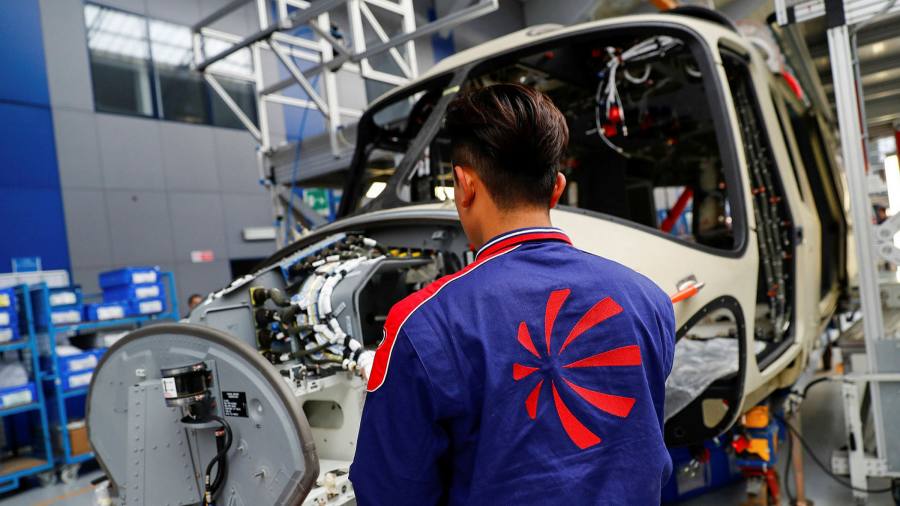[ad_1]
In 2018, it seemed a done deal. Engineers and mechanics at Yeovil in south-west England looked set to fill an $800m order to build a dozen anti-submarine helicopters for South Korea.
Not only were the AW159 Wildcat helicopters cheaper than their traditional US competitor, they were the South Korean navy’s incumbent machine. More importantly, when the order was put out to tender, their maker Leonardo Helicopters was the only bidder.
Three years later and the Italian-owned defence group is licking its wounds after the contract — including work from associated weapons and communications systems and support services — was awarded to US rival Lockheed Martin in December.
Ultimately, Seoul’s decision was not just a singular blow to Leonardo. While not the biggest defence industry deal, it raises questions over the strategy employed by companies that compete head-to-head for business against American rivals, particularly in countries where the US influence remains strong.
In South Korea alone the stakes are high. The country, already among the top 10 in military expenditure globally, is spending Won300tn ($275bn) over the next four years, including on big-ticket items such as a $1.7bn aircraft carrier. Others in the region, including Japan, Australia and India, have military modernisation programmes. This creates good opportunities for overseas defence companies, if they can get the work.
So, what went wrong for Leonardo? At a political level, American influence played a key role, and a lack of that on the British side did not help. Lockheed Martin, with support from the US government, entered a late bid to compete for the contract which Seoul’s Defense Acquisition Program Administration (Dapa) accepted.
Then, over the course of 2019, Donald Trump’s administration heaped pressure on Seoul to buy more US-made weapons. At the time, South Korea’s president Moon Jae-in was desperately trying to avoid aggravating the unpredictable US president who was contemporaneously demanding that Seoul quintuple what it pays the US for stationing troops in South Korea. Mr Moon was doubly cautious over risking Mr Trump’s ire because the US leader was critical in keeping South Korea’s dreams alive of rapprochement with North Korea.
South Korea’s Dapa is meant to make its decisions independently of Mr Moon and the presidential Blue House. But defence experts in Seoul say that the agency would have been acutely aware of the pressure on its government to buy American. A dearth of information offered by Dapa over the process has left some of those involved unclear as to the extent of apparent superiority of the Lockheed Martin MH-60R Seahawk.
Over the same period the UK government was, at senior levels, mostly preoccupied with Brexit and the Covid-19 pandemic. There was scant bandwidth available to counter the US pressure. Boris Johnson, the prime minister, and Mr Moon discussed defence industry co-operation on a November 10 phone call last year, according to the Blue House. But Mr Johnson’s overtures were insufficient to turn the dial in Leonardo’s favour.
Ultimately, the award of Seoul’s latest anti-submarine helicopters contract might have had more to do with geopolitics than the finer points of the machines’ flight physics.
The process has been instructive for companies. It suggests that non-US defence groups need to deepen their relationships with the fast-improving local defence industries, which the government will probably favour, even over Americans.
This is particularly true in countries where defence groups face the dual challenge of US companies backed by Washington, and pressure from national governments for greater levels of local involvement and import substitution in defence contracts. In South Korea, US weaponry accounts for about four-fifths of defence imports. The country’s own defence exports were $1.5bn in 2019, up from about $200m in the mid-2000s, according to defence publication Janes. That came on the back of growth of companies such as Hanwha Group, Korea Aerospace Industries, LIG Nex1 and Hyundai Rotem.
For European groups, partnering with locals would result in fewer chunky contracts but has the potential to deliver a greater number of smaller deals with a narrower scope of work. The companies will probably face pressure for technology transfers to local competitors, underscoring the need for Leonardo and its peers to redouble development efforts. It might not seem fair, but as they say, that is love and war.
edward.white@ft.com
@edwardwhitenz
[ad_2]
Source link





